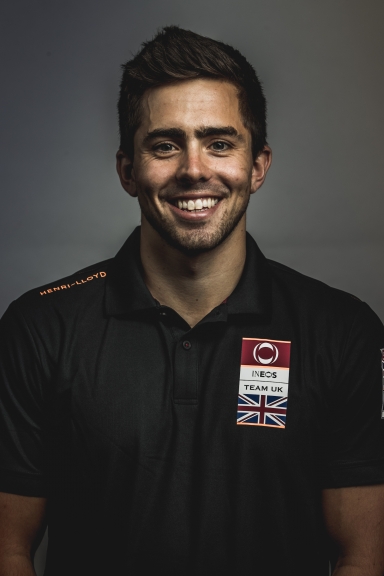Mainsail Trimmer, Bleddyn Mon
“I feel very fortunate to jump from Cup to Volvo and now back to the Cup. After Bermuda we knew there would be a period of ‘less action’ and it seemed like the best use of time was to go away and learn some new skills, sail a new boat and learn how to make it go fast."
Welsh sailor, Bleddyn Môn, returned to a British team for his second consecutive Cup campaign and with him brings experience from the AC35 in Bermuda alongside racing around the world in the Volvo Ocean Race. Bleddyn joined Volvo Ocean Race team, Turn the Tide on Plastic, days after the last race of AC35 in Bermuda teaming up with a mixed youth focused team led by Britain’s Dee Carrafi.
His position within INEOS TEAM UK is unique, he runs a duel role - as a sailor alongside a position with the performance and analysis team. He is also one of only three sailors within the team who has both Cup and Volvo Ocean Race Campaigns to their name.

© Lloyd Images
Bleddyn hails from Anglesey, at the north-western tip of Wales and it was aged 10 when he decided he wanted to become a pro sailor, “I grew up on Anglesey and as a family, we spent a lot of time going down the beach during summer holidays. My dad did a little bit of sailing at school when he was younger but not much. My mum didn’t do any sailing. We’re not a sailing family in any way. Essentially, we went to this beach and there was a sailing club there. Before we knew it, we’d had a go on a boat.
“Then my granddad got a Skipper 14. He did buy a lot of random stuff. He would bring it along and we’d go sailing at Traeth Bychan, a holiday beach, there are campsites all around it. We did some cruising around and had a picnic and what have you. I must have been five or six.”
It didn’t take long to get past the picnic stage. The Mirror dinghy was popular at the local sailing club, Red Wharf Bay Sailing and Water Sports Club. The home-build (initially at least), plywood family dinghy had been developed and promoted by the Mirror newspaper in the 1960s. “I have a couple of older brothers, there are two years between us and we got one or two Mirrors to start with; my two brothers would sail together in one Mirror and then I would sail with my dad in the other. We’d do a bit of sailing at the club, my brothers were probably getting a bit more competitive at that point because they would have been 10 and 12 years old. Essentially, I just followed them. I guess, being the little brother, I always wanted to do what they did.”
The three boys followed a trend at the club; as the children got older they moved out of Mirrors and into the single-handed Topper dinghy – a very popular class for juniors – and started to travel further afield to events. Then Dyfrig got selected from his performance at a Topper National Championships into the national junior squad. “I guess that’s when my parents realised, ‘Holy s**t, what have we done here?’"

The younger brothers soon followed and the whole family embarked on a circuit of events around the country. “We had bought this Volkswagen van, and had it converted into a camper van. We had that and we had a triple stacker trailer, we’d put all the Toppers in the back of it and we’d just go around the country.” Often the brothers would be at different events, hundreds of miles apart. “It was a bit of a logistical nightmare, particularly with my parents not having a sailing background, they wouldn’t have expected what was going to happen, I don’t think. They took it on. The whole competitive thing, national and international, it was all new.”
Life in the Môn’s household sounded particularly frantic in this period, because there wasn’t just the sailing. “I used to play cricket for the county too, I think when I was 13 or 14 I dropped most other sports and focused on sailing but, up until that point, I was playing cricket for the county, rugby for school, a lot of athletics. What else did I do? I played the trumpet, piano, there were family cycling holidays...”
In the end, it all got dropped in favour of the sailing. “l was probably 13 or 14 when I started realising I didn’t have the time and, for the rugby stuff, it was, ‘I'm going to get hurt, these lads are getting quite big now.’ I was serious about the cricket, but it was just that I knew I wasn’t as good at it. I could look at top cricket players and I couldn’t see the link between where I was and where they were.”
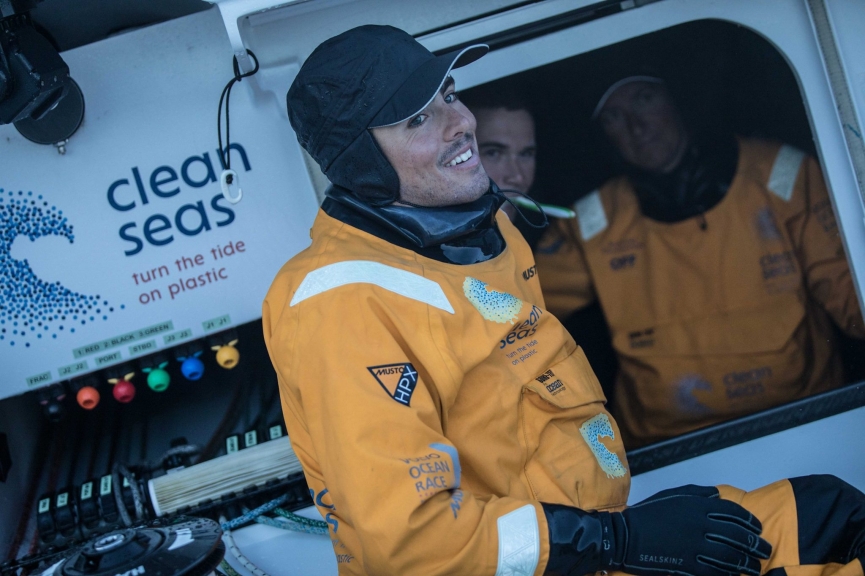
“In sailing, although I was just dreaming at that stage, I could see where the link was – I was part of a national squad when I was ten. There were people, coaches or whoever, that you could look at and see a bit of a route. I decided I was going to focus on sailing.” It was a win at the Topper National Championships in Largs in 2005 against 270 competitors that convinced him that he might have a future in the sport. The potential was confirmed a year later when he won it again at Weymouth, this time against 288 other boats. He was just 14 years old.
The designated pathway within the sport is to move from the Topper to the Laser, but Môn was much too light. “I was still 55kgs and no way was I going to go into a Laser. I was nowhere near big enough for it.” Bleddyn started to look at his options. “I got drawn to a 29er (the youth skiff class). I remember sailing that for the first time and I thought, ‘Oh my God, this is quick’. And then I found someone who had a boat and was an experienced crew. It was win-win.... We then did quite a bit of sailing out of Traeth Bychan – the beach on Anglesey – on our own, basically; me learning how to sail the thing. Lots of hours out there.
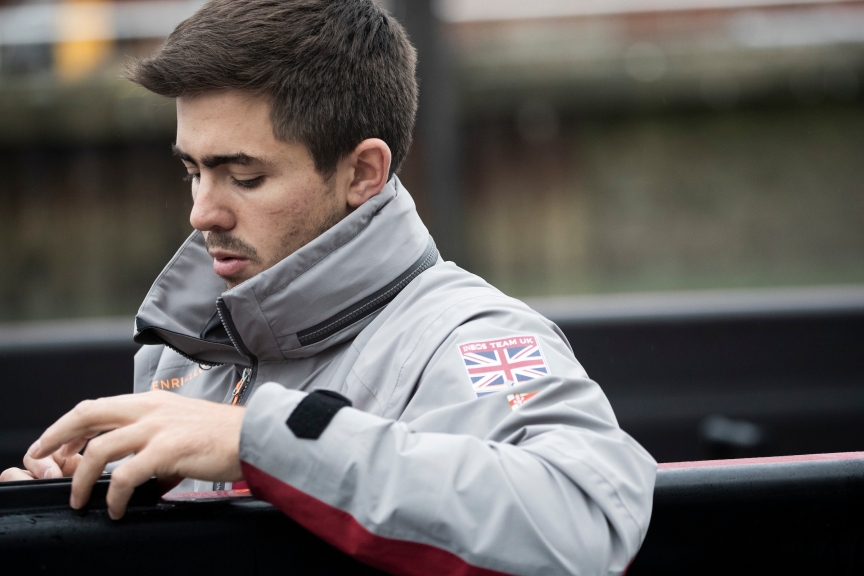
© Lloyd Images
Lloyd Images
“We won two national championships in that boat as well. I think the first one may have been in the first year. It was quite a rapid learning curve. By the time I was in the 29ers I knew it was what I wanted to do. I guess that’s when I was starting to bug my parents a little bit and say, ‘I know what I'm going to do, I'm going to be a professional sailor.’ Mum’s a career’s adviser, so you can imagine, it was like, ‘Okay but maybe you should keep working at school as well.’”
By the time he finished in the 29er, Bleddyn was in the second year of study for his A-levels, and once again the question was being asked about what to do next. “In the end, I went and did a year in a Laser Radial, went back to my singlehanded roots.” Logistically, it was a lot easier to have all three brothers in the same boat again, and he still needed to get his weight up to 70kgs to move up to the Olympic skiff, the 49er.
Meanwhile, with A* in Maths, Physics and Design Technology (STEM subjects) at A-level, he applied to Southampton University to study Mechanical Engineering with aerospace as a speciality. “It was mainly for the sailing, but it was one of the best places for engineering too. I considered Ship Science, but at the time I wasn’t sure what field of engineering I wanted to pursue, so opted to start studying MechEng and then specialise later. Also, at the time, I didn’t want to be overrun by sailing.” He also started to prepare for the move to the 49er class, buying a boat with a friend from 29er racing who would be at Portsmouth University. They joined the RYA’s transitional squad for the move up to the Olympic class and started to train hard in Weymouth.
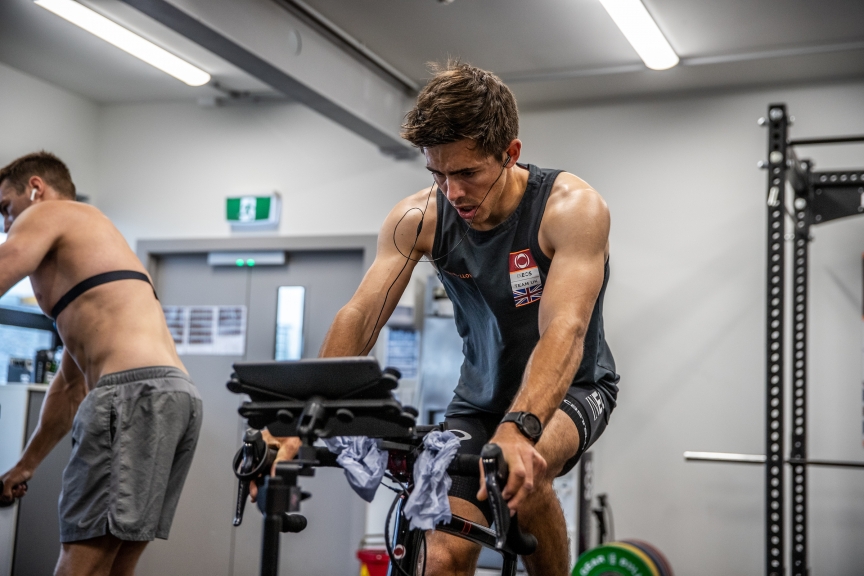
© C GREGORY
After a while, the Olympic ambitions started to drift and he sailed in other classes, and new openings outside the Olympic pathway started to arise. He raced in a couple of rounds of the Extreme Sailing Series with INEOS TEAM UK team mate, Leigh McMillan. And then a very different opportunity came up. “I applied for an internship at Red Bull Racing. I got an interview, and to my surprise I managed to get a job with the aerodynamics team for a year. When I got there, I learned so much. It was cool to see an organisation like that which has been around for a while, and to see how it all worked.”
Bleddyn moved to Milton Keynes, sharing a house with two friends from Southampton who also had internships there. He had accepted that for now he had to put his Olympic sailing ambitions on hold, and bought a foiling single-hander, the International Moth. He sailed it at a big local club (Grafham Water), and was also going to international events crewing in a three-person keelboat, the Etchells. Life wasn’t bad, but it wasn’t the Olympic dream.
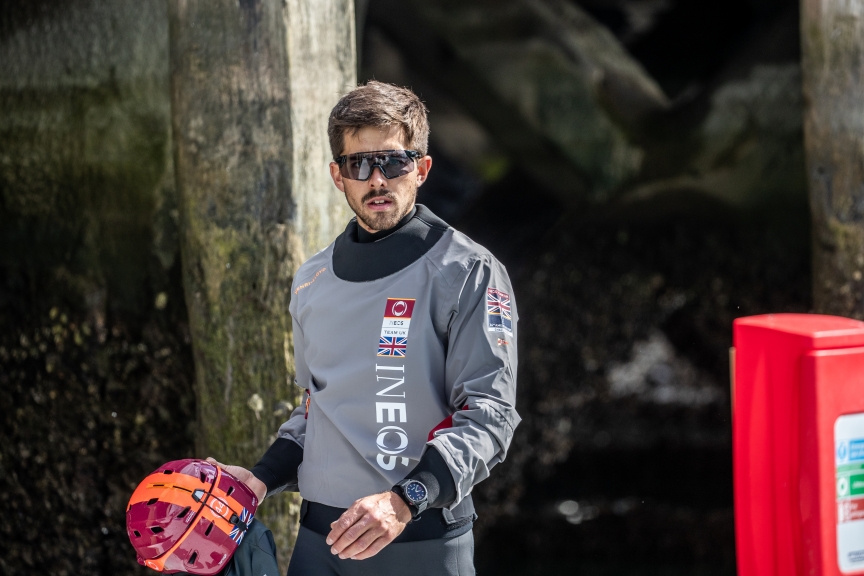
It was at this point that the America’s Cup in San Francisco caught his attention. “To be honest, that was the first time that I properly followed it, I knew about it but it was never really on my radar. I was Olympics, Olympics, Olympics. But when I saw the racing, I was like ‘wow, that’s cool’. And I’d walk into the office at Red Bull and there were people who probably knew nothing about sailing who would talk about it. Something was going on, and that’s what I wanted to get into.”
He started to talk to people and see where there might be an opening. In the early part of the summer of 2014, while still at Red Bull, he was introduced to the British America’s Cup team. At the time the team wanted someone to fill the slot for an Under-25 person on the team’s boat for Cardiff (Extreme Sailing Series), so he returned home to Wales to sail with them and continued to for the rest of the year.
The placement with Red Bull ended, and he returned to Southampton to finish his MEng, still sailing on the ESS circuit.
The autumn was a busy period, with three events on the Extreme Sailing Series, all whilst finishing his MEng dissertation, and preparing for exams in January. “I knew they weren’t going to carry on with the Extremes the following year so I approached Ben Ainslie Racing and we had a chat when I got back from an event in Sydney - rather jet-lagged - about what to expect from here and the fact that, once I finished, I was keen to join. It must have been the early part of 2015 when it all got ticked off at the end. Then I finished my degree. I went to Bermuda for a training camp, and I started with the Cup team officially on the 1st July 2015 and stayed with them for three years.

During his time with the British team his role was split between design, performance and analysis alongside the sailing. “Being part of the British team last time was a big highlight of my career so far - experiencing an America’s Cup environment and the racing for the first time. We had brilliant sailing conditions in Bermuda, the venue was great and the boats were exciting. I started off being more heavily focused on the design side, then later on as we ramped up to the main competition I did more sailing. We had highs and lows and as a new team there was a lot of catching up to do, but it meant there was a lot of development happening with the design and performance too so the pace in which things changed was really interesting for me personally.
“Towards the end of our time in Bermuda I had it on my radar that the Volvo Ocean Race was going to start in the October and I was approached by Dee (Caffari) who was setting up a youth focused team to try and get young sailors competing within the Volvo Ocean Race. In the end, the majority of our crew were under 30 years of age. Taking part in the race was just too good an opportunity for me to miss. The timing was perfect and it was a big challenge and so different to anything I had ever done previously. As we were a new and young team, it was continual learning too and we were given a lot of responsibility and constantly developing throughout the race."
“I feel very fortunate to jump from Cup to Volvo and back to the Cup, after Bermuda we knew there would be a period of ‘less action’ and it seemed like the best use of time was to go away and learn some new skills, sail a new boat and learn how to make it go fast."
Now firmly back embedded within the Cup environment, Bleddyn continues to manage the designer and sailor balance, resuming a similar role as before, supporting the performance team. “Personally, I feel like now, already having one Cup campaign under my belt, I have a better understanding of the process which will hopefully put me in a good place to perform well both on and off the water.”
